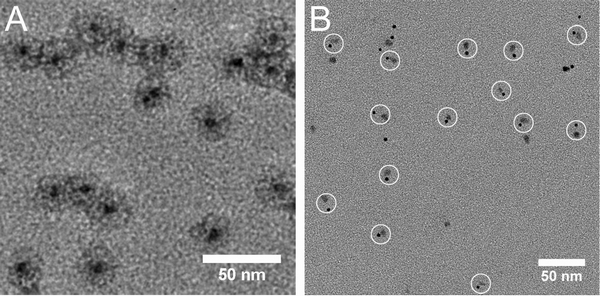Proteins are drawing more and more attentions as building blocks and scaffolds to assemble into diverse nanostructures and nanodevices, owning to their intrinsic properties such as homogeneous size and shape, easy manipulation through rational design/genetic engineering and facile scaling-up in large quantity. In particular, protein nanocages, like virus-based nanoparticles (VNPs), ferritins, and heat shock proteins, have been extensively investigated as nanoplatforms for synthesis of nanomaterial, organization of nanoparticles, fabrication of nanodevices, controllable delivery of bioactive molecules, etc. Breaking the symmetry and locally functionalizing the surface of a protein nanocage would enable the topological control over the nanoscale assembly guided by such scaffolds, as well as quantitative investigation of interactions among different entities, but remains a technical challenge.
Recently, Prof. WANG Qiangbin’s group from Suzhou Institute of Nano-Tech & Nano-Bionics, CAS, in collaboration with the Nanobiology Lab at Wuhan Institute of Virology, CAS, has developed a novel strategy to monofunctionalize protein nanocages. The VNP of simian virus 40 (SV40), which is assembled from twelve VP1 pentamers under appropriate conditions, has been used here to demonstrate this strategy. As shown in Figure 1, the VP1 pentamer is engineered for simultaneous introduction of surface-exposed cysteine and polyhistidine tag. The VNP is assembled by incorporating the functional VP1 pentamer and its nonfunctional counterpart at an optimal ratio (step 1). The polyhistidine tags make it possible to purify the monofunctionalized VNPs (mfVNPs) through nickel affinity chromatography (step 2). AuNP binding assay illustrates the monofunctionality nature of the as-obtained mfVNPs and the capability of mfVNPs in organizing heterogeneous nanostructure composed of one QD and one AuNP (step 3; Figure 2). The strategy can be generalized to other proteins and nanomotifs and readily used for monofunctionalization of inorganic NPs, deliberate design and construction of complex nanoarchitectures, single-particle tracking, as well as pre-orientated targeting imaging and drug delevery, etc. This work has been recently published in J. Am. Chem. Soc..
This work was supported by “Hundred Talents” program of the CAS and Strategic Priority Research Program of the CAS, NSFC, Ministry of Science and Technology and so on.
 |
|
Figure 1: Scheme of the construction of QD-mfVNPs. Image by SINANO |
 |
|
Figure 2: TEM images of QD-mfVNPs (A) and mfVNPs-guided Au/QD structures Image by SINANO |
downloadFile
